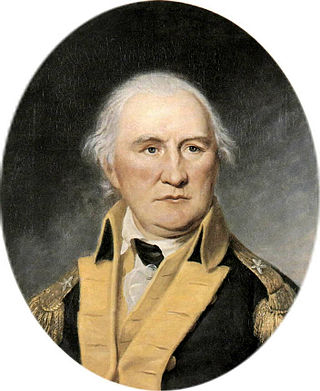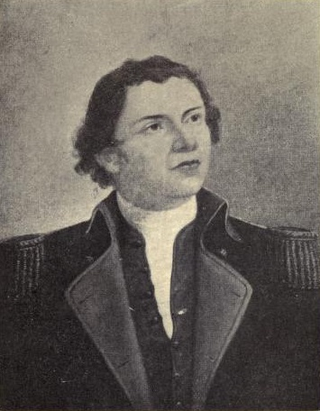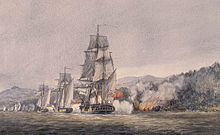
The Battle of Long Island, also known as the Battle of Brooklyn and the Battle of Brooklyn Heights, was an action of the American Revolutionary War fought on August 27, 1776, at and near the western edge of Long Island in present-day Brooklyn. The British defeated the Continental Army and gained access to the strategically important Port of New York, which they held for the rest of the war. It was the first major battle to take place after the United States declared its independence on July 4, 1776, in Philadelphia. It was the largest battle of the Revolutionary War in terms of both troop deployment and combat.

Daniel Morgan was an American pioneer, soldier, and politician from Virginia. One of the most respected battlefield tacticians of the American Revolutionary War of 1775–1783, he later commanded troops during the suppression of the Whiskey Rebellion of 1791–1794.

The Battle of White Plains took place during the New York and New Jersey campaign of the American Revolutionary War on October 28, 1776, near White Plains, New York. Following the retreat of George Washington's Continental Army northward from New York City, British General William Howe landed troops in Westchester County, intending to cut off Washington's escape route. Alerted to this move, Washington retreated farther, establishing a position in the village of White Plains but failing to establish firm control over local high ground. Howe's troops drove Washington's troops from a hill near the village; following this loss, Washington ordered the Americans to retreat farther north.

Hugh Mercer was a brigadier general in the Continental Army during the American Revolutionary War. He fought in the New York and New Jersey campaign and was mortally wounded at the Battle of Princeton.

William Smallwood was an American planter, soldier and politician from Charles County, Maryland. He served in the American Revolutionary War, rising to the rank of major general. He was serving as the fourth Governor of Maryland when the state adopted the United States Constitution.

New Jersey played a central role in the American Revolution both politically and militarily. It was the site of more than 90 military engagements, including the pivotal battles of Trenton, Princeton, and Monmouth. George Washington led his army across the state four times and encamped there during three hard winters, enduring some of the greatest's setbacks of the war as well as seminal victories. New Jersey's decisive role in the conflict earned it the title, "Crossroads of the American Revolution".

The Battle of Fort Washington was fought in New York on November 16, 1776, during the American Revolutionary War between the United States and Great Britain. It was a British victory that gained the surrender of the remnant of the garrison of Fort Washington near the north end of Manhattan. It was one of the worst Patriot defeats of the war.

The New Hampshire Line was a formation in the Continental Army. The term "New Hampshire Line" referred to the quota of numbered infantry regiments assigned to New Hampshire at various times by the Continental Congress. These, along with similar contingents from the other twelve states, formed the Continental Line. For the promotion of senior officials, this concept is particularly important. Officers of the Continental Army below the rank of brigadier general were ordinarily ineligible for promotion except in the line of their own state.

Jethro Exum Sumner was a senior officer of the Continental Army during the American Revolutionary War. Born in Virginia, Sumner's military service began in the French and Indian War as a member of the state's Provincial forces. After the conclusion of that conflict, he moved to Bute County, North Carolina, where he acquired a substantial area of land and operated a tavern. He served as Sheriff of Bute County, but with the coming of the American Revolution, he became a strident patriot, and was elected to North Carolina's Provincial Congress.

The Maryland and Virginia Rifle Regiment, most commonly known as Rawlings' Regiment in period documents, was organized in June 1776 as a specialized light infantry unit of riflemen in the Continental Army during the American Revolutionary War. The American rifle units complemented the predominant, musket-equipped, line infantry forces of the war with their long-range marksmanship capability and were typically deployed with the line infantry as forward skirmishers and flanking elements. Scouting, escort, and outpost duties were also routine. The rifle units' battle formation was not nearly as structured as that of the line infantry units, which employed short-range massed firing in ordered linear formations. The riflemen could therefore respond with more adaptability to changing battle conditions.
A flying camp was a military formation employed by the Continental Army in the second half of 1776, during the American Revolutionary War.

The Battle of Trenton was fought on December 26, 1776, during the American Revolutionary War campaign for New Jersey. In a surprise attack, the Continental Army led by George Washington attacked the winter quarters of a brigade composed primarily of German troops from Hesse-Kassel in Trenton, New Jersey. The Hessian brigade was under the command of Colonel Johann Rall; he died of wounds sustained in the battle, and about two thirds of his men were taken prisoner. It was the first major victory after a long string of defeats that had resulted in the loss of New York City, and was a significant boost to American morale. It was followed by two more American victories, first in a second battle at Trenton on January 2, 1777, and then on January 3 at Princeton.
Events from the year 1777 in the United States.
The 4th Continental Artillery Regiment, also known as Reign's Continental Artillery Regiment, was an American military unit during the American Revolutionary War. The regiment became part of the Continental Army on 10 June 1777 as Colonel Thomas Proctor's Continental Artillery Regiment. It was made up of eight artillery companies from eastern Pennsylvania. At the time of the regiment's formation, two companies were already in existence, one from as early as October 1775. One company served at Trenton in December 1776 where it performed well in action. In February 1777, Pennsylvania expanded its two-company battalion into an eight-company regiment. After officially joining the Continental Army, the regiment saw much fighting in the Philadelphia campaign in late 1777. Elements of Proctor's Regiment fought at Monmouth in June 1778 and joined the Sullivan Expedition in summer 1779.
The "German Battalion" was an infantry formation of the Continental Army during the American Revolutionary War. Authorized in May 1776 as an extra Continental regiment, the battalion recruited ethnic Germans from Maryland and Pennsylvania.
John Dagworthy (1721–1784) was from Trenton, New Jersey, and had a military career that spanned three wars. During King George's War Dagworthy recruited a company of soldiers and was given command over them. During the French and Indian War he was a captain in command at Fort Cumberland. When George Washington of the Virginia militia, returned with the survivors of the Braddock Expedition Dagworthy became involved in a lengthy dispute with Washington, challenging him over matters of rank and seniority. During the American Revolutionary War he was a brigadier general commanding the Sussex County (Delaware) militia.
In the first half of 1776, the Thirteen Colonies individually declared independence from the British Empire. On July 4, the Declaration of Independence marked the beginning of the United States.
This is a list of events in the year 1776 in New Jersey.




























